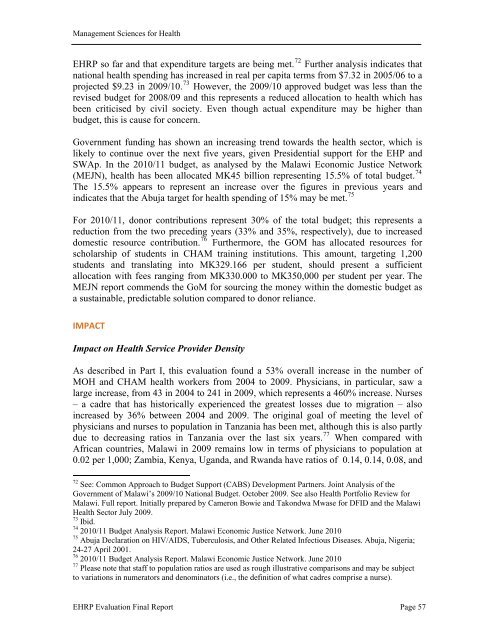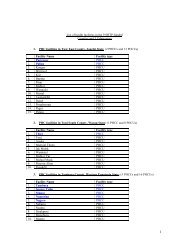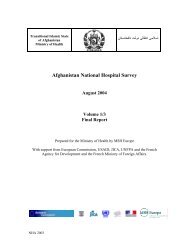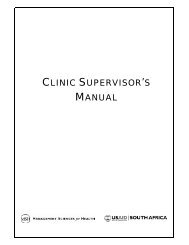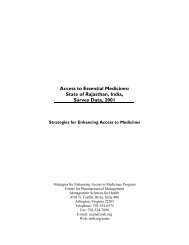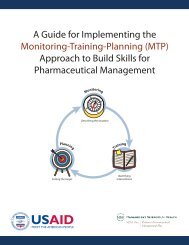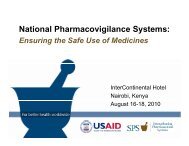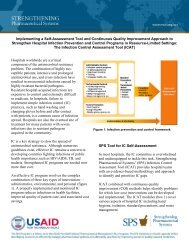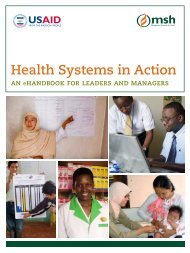Evaluation of Malawi's Emergency Human Resources Programme
Evaluation of Malawi's Emergency Human Resources Programme
Evaluation of Malawi's Emergency Human Resources Programme
You also want an ePaper? Increase the reach of your titles
YUMPU automatically turns print PDFs into web optimized ePapers that Google loves.
Management Sciences for Health<br />
EHRP so far and that expenditure targets are being met. 72 Further analysis indicates that<br />
national health spending has increased in real per capita terms from $7.32 in 2005/06 to a<br />
projected $9.23 in 2009/10. 73 However, the 2009/10 approved budget was less than the<br />
revised budget for 2008/09 and this represents a reduced allocation to health which has<br />
been criticised by civil society. Even though actual expenditure may be higher than<br />
budget, this is cause for concern.<br />
Government funding has shown an increasing trend towards the health sector, which is<br />
likely to continue over the next five years, given Presidential support for the EHP and<br />
SWAp. In the 2010/11 budget, as analysed by the Malawi Economic Justice Network<br />
(MEJN), health has been allocated MK45 billion representing 15.5% <strong>of</strong> total budget. 74<br />
The 15.5% appears to represent an increase over the figures in previous years and<br />
indicates that the Abuja target for health spending <strong>of</strong> 15% may be met. 75<br />
For 2010/11, donor contributions represent 30% <strong>of</strong> the total budget; this represents a<br />
reduction from the two preceding years (33% and 35%, respectively), due to increased<br />
domestic resource contribution. 76 Furthermore, the GOM has allocated resources for<br />
scholarship <strong>of</strong> students in CHAM training institutions. This amount, targeting 1,200<br />
students and translating into MK329.166 per student, should present a sufficient<br />
allocation with fees ranging from MK330.000 to MK350,000 per student per year. The<br />
MEJN report commends the GoM for sourcing the money within the domestic budget as<br />
a sustainable, predictable solution compared to donor reliance.<br />
IMPACT<br />
Impact on Health Service Provider Density<br />
As described in Part I, this evaluation found a 53% overall increase in the number <strong>of</strong><br />
MOH and CHAM health workers from 2004 to 2009. Physicians, in particular, saw a<br />
large increase, from 43 in 2004 to 241 in 2009, which represents a 460% increase. Nurses<br />
– a cadre that has historically experienced the greatest losses due to migration – also<br />
increased by 36% between 2004 and 2009. The original goal <strong>of</strong> meeting the level <strong>of</strong><br />
physicians and nurses to population in Tanzania has been met, although this is also partly<br />
due to decreasing ratios in Tanzania over the last six years. 77 When compared with<br />
African countries, Malawi in 2009 remains low in terms <strong>of</strong> physicians to population at<br />
0.02 per 1,000; Zambia, Kenya, Uganda, and Rwanda have ratios <strong>of</strong> 0.14, 0.14, 0.08, and<br />
72<br />
See: Common Approach to Budget Support (CABS) Development Partners. Joint Analysis <strong>of</strong> the<br />
Government <strong>of</strong> Malawi’s 2009/10 National Budget. October 2009. See also Health Portfolio Review for<br />
Malawi. Full report. Initially prepared by Cameron Bowie and Takondwa Mwase for DFID and the Malawi<br />
Health Sector July 2009.<br />
73<br />
Ibid.<br />
74<br />
2010/11 Budget Analysis Report. Malawi Economic Justice Network. June 2010<br />
75<br />
Abuja Declaration on HIV/AIDS, Tuberculosis, and Other Related Infectious Diseases. Abuja, Nigeria;<br />
24-27 April 2001.<br />
76<br />
2010/11 Budget Analysis Report. Malawi Economic Justice Network. June 2010<br />
77<br />
Please note that staff to population ratios are used as rough illustrative comparisons and may be subject<br />
to variations in numerators and denominators (i.e., the definition <strong>of</strong> what cadres comprise a nurse).<br />
EHRP <strong>Evaluation</strong> Final Report Page 57


